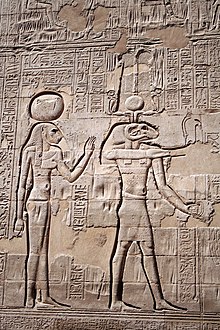Menhit
| Menhit | ||||||||
|---|---|---|---|---|---|---|---|---|
Nubian lioness goddess of war and the Sun | ||||||||
 Menhit on the left with Khnum on the right, shown on the outside wall of the temple atEsna | ||||||||
| Name inhieroglyphs | ||||||||
| Consort | Khnum | |||||||
| Offspring | Heka | |||||||
| Equivalents | ||||||||
| Egyptian equivalent | Sekhmet | |||||||
| Igbo equivalent | Anyanwu | |||||||
| Mesopotamian equivalent | Inanna | |||||||
Menhit/ˈmɛnˌhɪt/(also known asMenhyt,andMenchit) was originally aNubianlion goddess of war in theKingdom of Kush,who was regarded as atutelaryandsun goddess.[1]Her name means either "she who sacrifices" or "she who massacres."[2]AsMenhit,she is associated with thesun,but asMekhit,she is associated with themoon.[3]
History[edit]
Believed to have origins as a Nubian goddess, Menhit is always depicted as a lioness with solar disk and auraeussymbol.[1][4]Coffin texts associate her with being a tutelary and solar deity.[1]Some sources identify her as the subject of the "Distant Goddess" myth. In one legend, theEye of Raflees from Egypt. Her counterpart,Ra,sends another god to track her down in Nubia, where she transforms into a lioness. When she is returned to Ra, she either becomes or gives birth to Menhit.[3]
She also was believed to advance ahead of the Egyptian armies and cut down their enemies with fiery arrows, similar to other war deities.[5]She was less known to the people as a crown goddess[6]and was one of the goddesses who represented the protectiveuraeuson royal crowns.[1]
Cults[edit]
In the 3rdNomeofUpper Egypt,particularly atEsna,Menhit was said to be the wife ofKhnumand the mother ofHeka.She was also known to be the mother ofShu.[7]She was also worshipped inLower Egypt,where she was linked with the goddessesWadjetandNeith.[1]She became identified with another lioness goddess,Sekhmet.[5]
References[edit]
- ^abcdeWilkinson, Richard H. (2017).The Complete Gods and Goddesses of Ancient Egypt.Thames & Hudson. p. 179.ISBN978-0-500-28424-7.
- ^Farid, Mona; Fekri, Magdi Mohamed; Abd-elaal, Magdi Ismail (Hesham Ezz-eldin). "Archeological Study of Wild Animals in the New Kingdom".University of Sadat.ResearchGate.Retrieved 2023-09-07
- ^abMark, Joshua J. (2016-04-14)."Egyptian Gods - The Complete List".WorldHistory.org.Retrieved2023-09-03.
- ^Budge, E. A. Wallis (2018-08-28).The Ancient Egyptian Book of the Dead: Prayers, Incantations, and Other Texts from the Book of the Dead.Crestline Books.ISBN978-0-7603-6443-7.
- ^abHans Bonnet:Menhit,in:Lexikon der ägyptischen Religionsgeschichte(English: Lexicon of Egyptian History of Religion) p.451f
- ^Felde, Rolf (2017-12-29).Gottheiten, Pharaonen und Beamte im alten Ägypten(in German). BoD – Books on Demand. p. 34.ISBN978-3-7460-4935-9.
- ^Budge, E. A. Wallis (1920).An Egyptian Hieroglyphic Dictionary with an Index of English Words, King List and Geological List Vol. 1.London: John Murray. pp. 303–304.
Literature[edit]
- Rolf Felde:Ägyptische Gottheiten.Wiesbaden 1995
- Hans Bonnet:Lexikon der ägyptischen Religionsgeschichte,Hamburg 2000;ISBN3-937872-08-6


